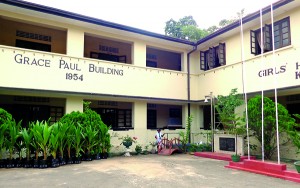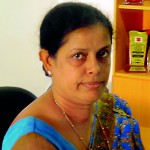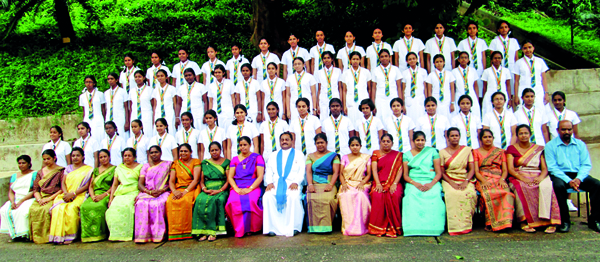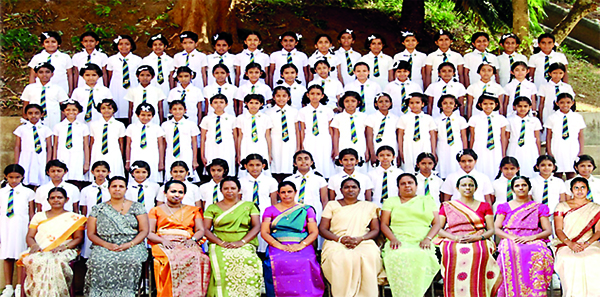Producing leading ladies with lofty ideals
View(s):The dawn of the 19th century witnessed competition among numerous missionaries setting up bilingual and svabhasha schools

The Appearance of the college
countrywide that provided educational opportunities for the general public. Yet it was not until seven decades had elapsed that the Methodist missionaries decided to establish high schools which were unique in character. The Methodist Church in March 1879 unanimously agreed to a proposal on instituting a high school for girls. Led by Rev. Samuel Langdon and his wife, the idea soon materialized with the creation of the new school at the Wesleyan Chapel at Katukele on May 21 of the

Ms. M. Abeygunasekara , Principal
same year.
The first principal of Girls’ High School Kandy (GHSK), Ms. Payne, arrived from England in July and served until February 1880. The school began humbly with only 70 pupils registered. But eventually the steadily rising student numbers compelled GHSK’ governors to relocate the school to the Methodist Church at Brownrig Street (present Yatinuwara Veediya) in Kandy. The decade saw a succession of renowned ladies of British origin serving as principals of the school with great commitment. Ms. Lawrence took over as the principal in 1890 and served for the whole decade, heavily engaged in development. A significant landmark of the early history is symbolized by the achievement of an outstanding student, Ms. Pricilla Marshal, becoming the first woman graduate in 1898.
Ms. F.R. Samson became the principal in 1901 and served for long eighteen years until 1919, marking a period of revolutionary  transformation when the school grew into a great institution of unique traditions and values. One of the important milestones of the school’s history was the introduction of Sri Lanka’s Scouts
transformation when the school grew into a great institution of unique traditions and values. One of the important milestones of the school’s history was the introduction of Sri Lanka’s Scouts
Movement in July 1917 under the leadership of Ms. J. Calverley. It was followed by establishing the Little Friends Movement (Brownie Company) in 1921 and the first Girl Guide Movement (Ranger Company). Ms. Gladys Vanderstraten became the first Girl Guide leader of the country, embellishing the school’s hat with another feather. The pioneer role High school has played in Sri Lanka’s Scout Movement continues to be legendary. The Old Girls’ Association of the school was formed in 1909 and now has a proud history of loyal commitment for over a century toward the educational, infrastructural and societal advancement of the school.
The school was permanently relocated to its present location on Peradeniya Road in 1921. It also proceeded to launch many firsts. The school uniform with a neck tie, the student house system, the crests of the school and student houses, and the prefect system are a few of these traditions introduced by GHSK. Also it became the first school to play netball. In 1947 GHSK received its first principal of Sri Lankan origin, Ms. Grace Paul, who served until 1955.
State takeover of the schools owned by Christian missions in 1961 was a major turning point of the school toward providing education for the masses of the country. Ms. Hema Jayasinghe, a past pupil as well as a teacher of GHSK, became the principal marking a new era of the school’s history. She was followed by Ms. T.K. Ekanayake appointed at the school’s 90th anniversary in 1969 who continued for twenty-one years in office. Significant new developments in all aspects of the school were commenced during her tenure and

Students who obtained 9As in the G.C.E.(O/L) Examination, 2012
continued by her successors Ms. H.M.M.K. Amunugama, Ms. G.N. Silva, Ms. R.N. Amarasinghe and Ms. H.M. Wataliyadda.
Ms. M. Abeygunasekara, the principal since 2007, carries on the mission of the school with great commitment and vigour, steering GHSK toward excellence. Her services were recognized with an honourary title of Colonel (Brawe) awarded by H.E. the President and with the “Guru Prathibha Prabha” award for the Best Principal in the Kandy Zone by the Ministry of Education. With a student population of 5,425, a tutorial staff of 201 and an auxiliary staff of 19 the school continues to be one of the most popular and prominent institutions in the country. The multi-cultural composition of the school community and the education offered in Sinhala, Tamil (Grade 1-13) and English (Grade 6 – 13) are symbolic of GHSK’s policy of providing equal opportunities for everyone.
The past few years saw continuous and sustained growth of students’ performance in academic as well as extra-curricular arenas. Annual achievements and successes of GHSK are too many and too diverse to be listed. GHSK has always been among the top-ranking schools of the country sought after by Grade 5 scholars. Moreover, outstanding performance of GHSK students at the Grade 5 scholarship examination has ranked it first in the Central Province. Excellent achievements at the GCE O/L examination every year have placed GHSK at the highest levels regionally and nationally. A large number of GHSK students enter state universities annually through their outstanding GCE A/L examination results. For several years the school remained first overall in GCE A/L results in the Central Province.

Students who got through the 2012 grade 5 scholarship examination
Sports constitute an integral part of education at GHSK. A range of sports such as netball, basketball, hockey, badminton, table tennis, swimming, chess, karate and athletics are offered to its students ensuring physical and character development together with education. The school is represented at all national level tournaments with remarkable achievements by GHSK’ sports teams and individuals. GHSK sports extend even toward overseas tournaments where significant accomplishments have been made by her sportswomen. Some recent highlights of international achievements of GHSK students include chess tournaments in Romania and Turkey, and netball championship in Brunei.
Various literary societies, clubs and associations exceeding 25 in number, formed by the students and mentored by the teachers, promote a well-balanced education with the view of moulding students with a perfect character.
Over the past 135 years, Girls’ High School Kandy has consolidated her position in the country’s education system as a force to be recognised. And the school still continues with its noble mission to “train girls to be women of character, to fit them to meet the strains and stresses of a wider world, to be mature women willing to serve their homes, society and their fellow men with integrity, loyalty, honesty and discipline.”
Sujitha Miranda
Follow @timesonlinelk
comments powered by Disqus


